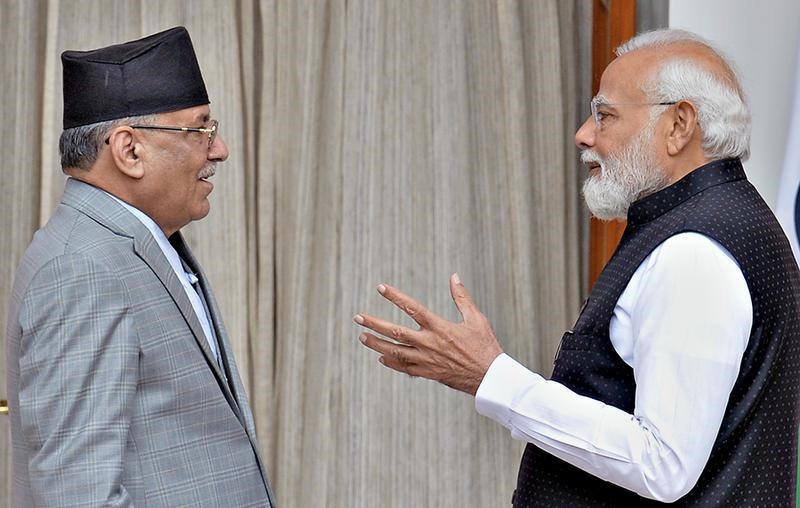Description

Disclaimer: Copyright infringement not intended.
Context
- The border between India and Nepal should not become a barrier, PM Modi said as the two sides signed a series of agreements on energy and transport, including export of Nepal’s hydropower to Bangladesh through Indian territory.
Highlights
- Welcoming Prime Minister Pushpa Kamal Dahal ‘Prachanda’, who is on a four-day visit to India, PM Modi said the two countries should fast-track projects related to the Ramayana circuit.
- Both sides signed the Transit Agreement. It will help Nepal’s population access India’s inland waterways.
- India would take forward the 2022 India-Nepal vision document for cooperation in the power sector that sets an ambitious goal in India-Nepal power trade and transmission.
- Taking this forward, a long-term Power Trade Agreement has been signed between India and Nepal.
- Under this agreement, a target of importing 10,000 MW of electricity from Nepal in the coming years has been set.
- Focusing on energy cooperation, a new pipeline will be constructed from Siliguri to Jhapa in eastern Nepal.
- The two sides signed a number of agreements, including an MoU between NHPC and VUCL (Vidyut Utpadan Company Ltd.) of Nepal, for the development of Phukot Karnali Hydroelectric Project and a Project Development Agreement for Lower Arun Hydroelectric Project between SJVN (India) and Investment Board of Nepal.
- The two PMs agreed to “achieve tangible and time-bound progress on the Pancheshwar multipurpose project”.
- The two Prime Ministers participated through a video link in the ground breaking ceremony of the Gorakhpur-Bhutwal Transmission Line — on the Indian side.
- The two Prime Ministers jointly inaugurated a cargo train from Bathnaha in India to Nepal Customs Yard.
- They also inaugurated integrated checkposts (ICPs) at Nepalgunj in Nepal and Rupaidiha on the Indian side.
- They participated in the ground breaking ceremony of ICPs at Bhairahawa and Sonauli as well as Phase-II facilities as part of the Motihari-Amlekhgunj Petroleum Pipeline.
Other developments
- Prime Minister of Nepal called on the President of India.
- Hours before the PM took off from Kathmandu, President Ram Chandra Poudel gave his assent to a controversial amendment to Nepal’s citizenship law that grants almost instant citizenship — along with guaranteed political rights — to women foreigners married to Nepalis.
- It makes Nepal’s citizenship law among the world’s most liberal.
- The action is likely to upset China, which has been warning that the law may give descendants of Tibetan refugees citizenship and property rights.
.jpeg)
Analysis of the visit
- Regular reciprocal visits by heads of state/government had been a bilateral tradition until 1997, after which India continued to host Nepali leaders, but not making reciprocal visits.
- While India’s role in mobilising external support in favour of the establishment of the secular republic in 2006 was widely appreciated, its attempts at “micro management” in Nepal resulted in a significant loss of goodwill.
- Also, the increased western role in Nepal saw China take aggressive counter-steps to increase its presence and influence in the country.
- Prachanda was earlier perceived as being pro-China, with a view of the US and India as “imperialistic and hegemonic forces”.
- However, the Prime Minister is now widely expected to assure India that he is amenable to aligning with it to contain the influence of China.
- Last February, Dahal had made political U-turn by joining hands with the Nepali Congress to have the $500 million US grant under the Millennium Challenge Corporation Nepal Compact ratified by Parliament, abandoning his party’s view that it was part of the “Indo-Pacific security plan” that would undermine Nepal’s diplomatic non-alignment.
- The approval of the citizenship law is seen as another outreach to India and the US.
- He also appears keen to be seen as respecting the sentiments of Nepali Hindus by including Indore and Ujjain — cities with important Shiva temples — in his itinerary.
- Apart for the political instability and a looming economic crisis in his country, Dahal is also concerned about possible Indian backing for royalists who want Nepal’s Hindu kingdom restored.
- There has been progress on resolving the points of friction around hydropower projects that India is executing in Nepal.
Mural of Akhand Bharat Controversy
- A major controversy has broken out in Nepal over a mural depicting the Indian subcontinental landmass in the newly inaugurated Parliament building.
- The mural has been interpreted as a map of Akhand Bharat or undivided India, which has drawn angry responses from Nepali political leaders across party lines.
- The mural shows Lumbini, the birth place of Gautama Buddha, indicating India’s claims over the region.
- Nepal considers Lumbini as one of the major cultural centres on the Nepalese map.
- The issue has once again triggered memories of the Kalapani dispute, which erupted in November 2019 when India published a political map showing the Kalapani region as part of Uttarakhand.
- Nepal, in response, published a map asserting its control over Kalapani,
Background of Relations
- As close neighbors, India and Nepal share unique ties of friendship and cooperation characterized by an open border and deep-rooted people-to-people contacts of kinship and culture.
- There has been a long tradition of free movement of people across the border. Nepal shares a border of over 1850 km with five Indian states – Sikkim, West Bengal, Bihar, Uttar Pradesh and Uttarakhand.
- The India-Nepal Treaty of Peace and Friendship of 1950forms the bedrock of the special relations that exist between India and Nepal. Nepalese citizens avail facilities and opportunities on par with Indian citizens in accordance with the provisions of the Treaty.
- Nearly 8 million Nepalese citizens live and work in India.
- Nepal is a unique country whose citizens can enrol into the Indian civil services as also the Army, which bestows an honorary General’s title to the Nepal Army Chief, a gesture that is reciprocated in equal terms.
Defence Cooperation
- India has been assisting the Nepal Army (NA) in its modernisation by supplying equipment and providing training.
- Assistance during disasters, joint military exercises, adventure activities and bilateral visits are other aspects of India’s defence cooperation with Nepal.
- A number of defence personnel from Nepal Army attend training courses in various Indian Army training institutions.
- The ‘Indo-Nepal Battalion-level Joint Military Exercise SURYA KIRAN’is conducted alternately in India and in Nepal.
- The Gorkha regimentsof the Indian Army are raised partly by recruitment from hill districts of Nepal.
2015 Earthquake in Nepal
- Government of India swiftly dispatched National Disaster Response Force (NDRF) teams and special aircrafts with rescue and relief materials to Nepal.
- The total Indian relief assistance to Nepal amounted to over US$ 67 million.
- The Government of India announced a post-earthquake reconstruction package of US$ 1 billion(which comprises US$ 250 million grant and US$ 750 million concessional Line of Credit)
Connectivity and Development Partnership
- Government of India’s development assistance to Nepal is a broad-based programme focusing on creation of infrastructure at the grass-roots level, under which various projects have been implemented in the areas of infrastructure, health, water resources, education and rural & community development.
- In recent years, India has been assisting Nepal in development of border infrastructure in the Terai area; development of cross-border rail links at Jogbani-Biratnagar, Jaynagar-Bardibas; and establishment of Integrated Check Posts at Birgunj, Biratnagar, Bhairahawa, and Nepalgunj.
- The total economic assistance earmarked under ‘Aid to Nepal’ budget in FY 2019-20 was INR 1200 crore.
- Apart from grant assistance, Government of India has extended Lines of Credit of USD 1.65 billion for undertaking development of infrastructure.
- ‘India-Nepal New Partnership in Agriculture’was launched in 2018.
Water Resources Cooperation
- A three-tier bilateral mechanism established in 2008, to discuss issues relating to cooperation in water resources, flood management, inundation and hydropower between the two countries, has been working well.
Energy Cooperation
- India and Nepal have a Power Exchange Agreement since 1971for meeting the power requirements in the border areas of the two countries, taking advantage of each other's transmission infrastructure.
- India is currently supplying a total of about 600 MW of power to Nepal.
- An Agreement on ‘Electric Power Trade, Cross-border Transmission Interconnection and Grid Connectivity’ between India and Nepal was signed in 2014.
- South Asia’s first cross-border petroleum products pipeline connecting Motihari in India to Amlekhgunjin Nepal was inaugurated in

Economic Coperation
- India is the largest trading partner of Nepal.
- Total bilateral trade in 2018-19 reached INR 57,858 cr.
- In 2018-19, while Nepal’s exports to India stood at INR 3558 cr, India’s exports to Nepal were INR 54,300 cr.
- Indian firms are among the largest investors in Nepal, accounting for more than 30% of the total approved foreign direct investments.
Education and Culture
- GoI provides around 3000 scholarships/seats annually to Nepalese nationals for various courses at the Ph.D/Masters, Bachelors and plus–two levels in India and in Nepal.
- GoI initiatives to promote people-to-people contacts in the fields of art & culture, academics and media include cultural programmes, symposia and events organized in partnership with different local bodies of Nepal, as well as conferences and seminars in Hindi.
|
PRACTICE QUESTION
Q) There is an increasing tendency among Nepalese politicians to use anti-India rhetoric as also push their two powerful neighbours in covert manoeuvres for domestic political gains. Discuss. (250 words)
|

https://pib.gov.in/PressReleasePage.aspx?PRID=1929110












